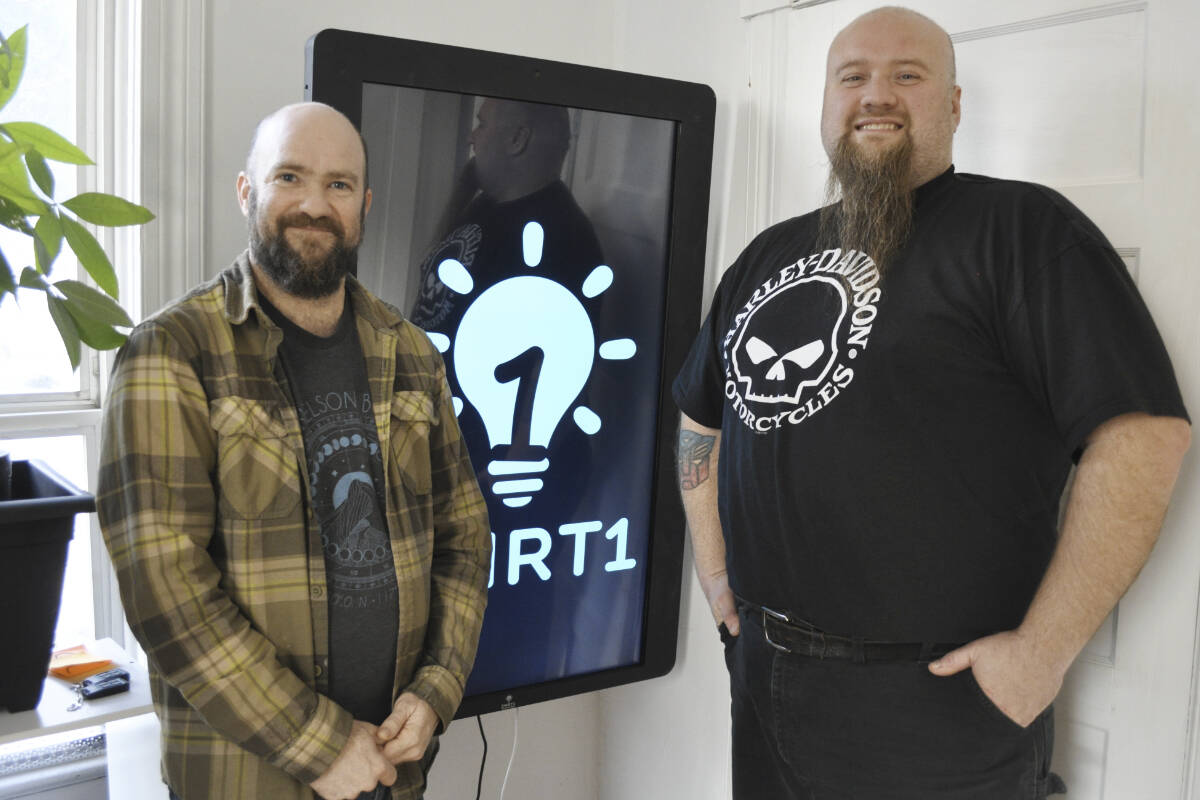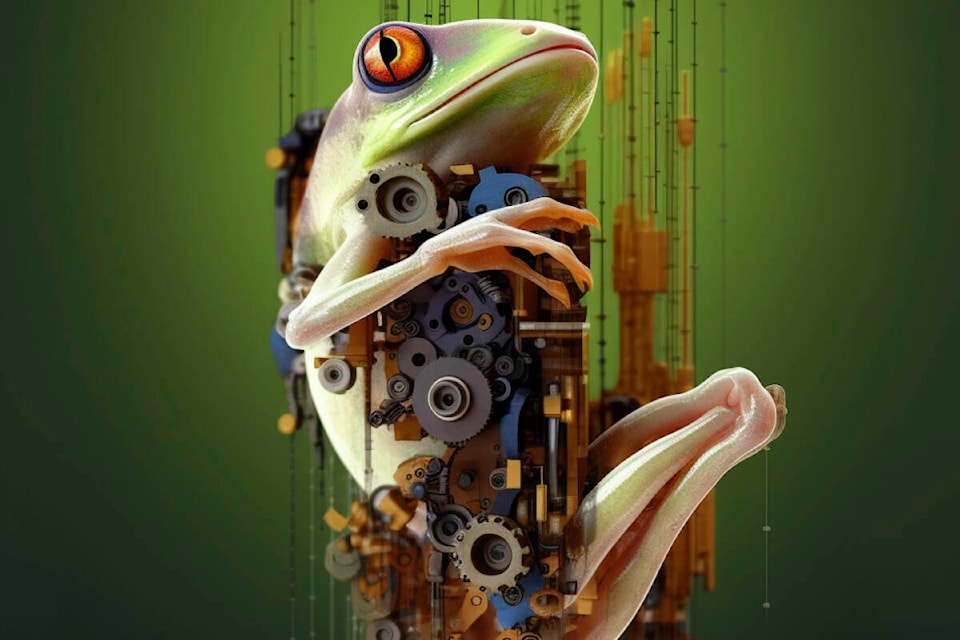This story was written by the AI chatbot ChatGPT-4 using Nelson Star editor-reporter Tyler Harper’s notes. To see how Harper wrote this story, click here.
Zan Comerford, founder of Litework Marketing in Nelson, had her world turned upside down when she first encountered ChatGPT, the AI language model by OpenAI. Initially fearing for her job and the future of humanity, she later found that the AI could be useful as “a third party to bounce ideas off of and get original ideas,” although not of the same quality as human work.
“If a machine gives you the bones, then you can build from there. I haven’t experienced anything with AI or ChatGPT yet that I would publish without tweaking, so that makes me feel a little bit more relieved,” Comerford explained. She also mentioned that while some of her marketing colleagues are competitive about incorporating AI quickly, others share her concerns.
Comerford works with 10-to-15 clients in tourism events and cannabis marketing. She has found that clients are already inquiring about outsourcing work to ChatGPT, but they quickly realize the quality isn’t the same. Comerford believes that people who become experts at prompting ChatGPT will become valued in the industry. However, she also expressed concerns about plagiarism and the idea that “it does feel like it’s this tipping point where now humans are interacting with machines in a way that there’s not going to be a return from.”
Meanwhile, Brad Pommen, CEO of SMRT1 Technologies, and Gregg Coppen, product designer and front-end developer, have been exploring ChatGPT’s potential. They found that the AI doesn’t replace anybody at this point, but it’s not far off from needing fewer resources and doing more with less.
“There was nothing that prepared me to see how far this went and how fast,” said Pommen, who believes the AI will require expertise to use effectively. He compared it to a specialized tool, like a high-quality paintbrush.
On the topic of coding, Pommen doesn’t think it will replace creative coders, but Coppen believes it might democratize coding. “Knowing that it needs a semicolon here and a bracket and another closing bracket there and it needs to be indented this much, I think a lot of that very technical domain is going to be sort of abstracted away,” Coppen explained.
Pommen remains optimistic about the future of AI, seeing it as an opportunity for creativity and programming for non-programmers. Coppen calls ChatGPT a “benchmark moment” in the internet. However, he also joked about not wanting his daughter to know about ChatGPT, fearing she would never write a word again.
As AI continues to evolve and impact various industries, professionals like Comerford, Pommen, and Coppen will need to adapt and find the best ways to utilize these new tools while maintaining the value of human creativity and expertise.

The classroom is real. The teacher isn’t
Online French tutor Hazel Mousley is among those who have discovered the benefits of using ChatGPT for teaching languages. Mousley believes ChatGPT’s humaneness and its ability to engage students make it an effective learning tool.
Mousley, whose clients range from four-to-80 years old, notes that the AI can produce interesting material for learners at any level. Her most engaged students treat ChatGPT like a friend and her as a witness to their interactions.
One of her students, a 10-year-old girl who loves figure skating, was captivated by a short play written by ChatGPT in French. The simple vocabulary and hilarious content helped the student stay focused and retain new vocabulary more effectively. Another student improved his French writing skills by conversing with ChatGPT, despite his previous struggles with spelling.
Mousley also praises ChatGPT’s ability to interpret poor grammar and spelling, as well as its understanding of slang. She reveals that almost all the online French tutors she knows now use ChatGPT. However, she remains uncertain about its use in a classroom setting and its potential for misuse by lazy students.
Dr. Theresa Southam, Selkirk College co-ordinator of the Teaching and Learning Centre, initially feared that ChatGPT would make instructors obsolete but has since changed her mind. “New technology comes on board, and then we realize we really need to engage with that and there are still lots of things that we can teach students that technology can’t,” she said.
Southam acknowledges ChatGPT’s limitations, such as its lack of common sense, empathy, and personalization. She also raises concerns about cheating and the need for more nuanced questions in assessments to challenge students to think creatively and critically.
While ChatGPT can generate content from various sources, Southam points out that it may not always draw from reputable sources or provide context-specific responses. She emphasizes that the AI represents only a part of human collective intelligence and may omit perspectives from oral histories or those without access to technology.
The master and apprentice
Abby Wilson, a business analyst by day and an artist in her free time, has been experimenting with AI-generated art using Midjourney, a platform that generates images based on user inputs. Wilson began using Midjourney in November and has since created various artworks, including an illustration for her toddler daughter about being gentle with cats, using AI-generated poems as prompts.
Wilson praises Midjourney for its ability to create colour palettes and generate multiple visual variations of her ideas. However, she acknowledges that the AI-generated images often lack detail and can exhibit errors. “I think first draft is a good way to think about it, or just making a visual variation like taking an old painting and being like, how could I have made this better? Just different takes on an idea,” she said.
Despite concerns that AI-generated art could threaten the livelihood of artists, Wilson is not worried. She believes that the art market still values original artwork over AI-generated versions. “I don’t feel super threatened because it is kind of like a first draft, and the nature of the art market is that originals do have more value,” she said.
Wilson also pointed out that AI-generated images tend to resemble each other, particularly in specific subjects like mountains, and may not capture unique features of a particular place. She also expressed concern about the potential bias against minorities in AI-generated images, as the AI is trained on images available on the internet, which may be predominantly Caucasian-focused.
Midjourney has faced controversy among artists who argue that they did not give consent for their images to be used for training the AI. Wilson believes that the platform works best as a reference or for inspiring ideas. For example, she provided Midjourney with a photo of the Kootenay Lake ferry, and although the returned images were not perfect, they inspired her to create a painting combining elements from each.
Wilson is comfortable with the ethics of using Midjourney when working with her own sketches and reference images, but she is not interested in using it to copy art or reference from artists trying to make a living. “I feel like if I’m using my own sketches and reference images and working with it, I’m OK with that. Maybe it’s behind the scenes referencing a bunch of stuff that I don’t know about, but I still feel like I’m making a lot of decisions there,” she said.
That certain something
Avi Phillips, owner of Transform Your Org, a digital services company specializing in data management, analytics audits, and website accessibility, and Joe Boland, a Trail-based health coach and owner of Darn Strong Dads, have both embraced the use of ChatGPT to enhance their respective businesses.
Phillips’ first experience with ChatGPT was “mindblowing,” comparing it to Google, which only returns websites as results, whereas ChatGPT synthesizes information in a conversational manner. He uses it for creating content, developing outlines, and answering questions about coding. “It feels like life has changed again, and we can’t go back. It’s the Pandora’s box. It’s open and everybody has access to this opportunity now to stylize their lives,” Phillips said.
However, Phillips also expressed concerns about the potential negative uses of AI, such as hacking and spreading misinformation, and the ethical implications of releasing AI to the public before its final version. “We’re all part of this guinea pig training for this AI,” he remarked.
Boland utilizes ChatGPT to save time, draft coaching curriculums, and find inspiration for new ideas. He appreciates the organic responses it provides compared to more rudimentary chatbots. “With ChatGPT, you can punch in practically anything and then it will come back with an answer that is largely very organic reading,” Boland said.
However, Boland acknowledges that ChatGPT falls short when addressing specific client needs, and he would not use it as a sole source of direction. He also believes that people will always prefer human interaction over AI, especially when dealing with sensitive topics like health and wellness. “We need that human connection that I don’t think AI can necessarily offer,” Boland added.
Both Phillips and Boland advocate for more rigorous fact-checking and responsible AI use, as they continue to explore the potential of ChatGPT to enhance their businesses and industries.
READ MORE:
• B.C. researchers use AI to predict a cancer patient’s survival rate with 80% accuracy
• What can ChatGPT maker’s new AI model GPT-4 do?
• This Canadian VFX studio is using AI to cosmetically alter your favourite actors
@tyler_harper | tyler.harper@nelsonstar.com
Like us on Facebook and follow us on Twitter.
